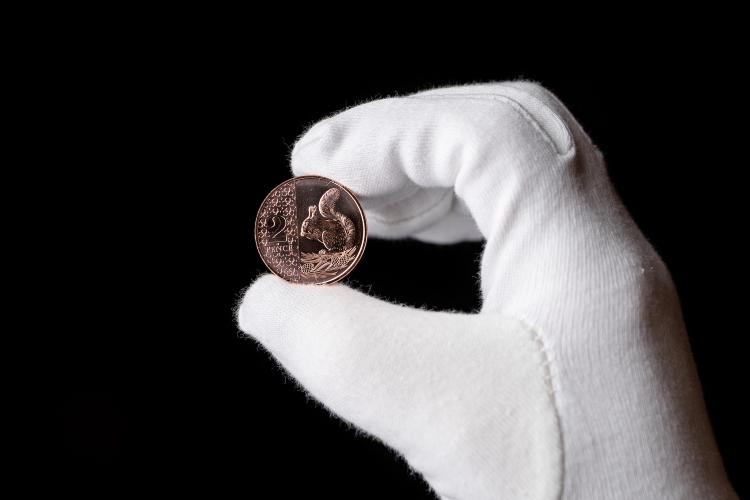Royal Mint reveals new set of coins inspired by UK flora and fauna
The designs feature a mix of endangered species and conservation success stories and are set for general circulation.
The Royal Mint has unveiled eight new coin designs inspired and approved by King Charles III, referencing his passion for conservation and nature.
Officially known as definitives, the new set of coins marks the final chapter of King Charles III’s transition onto British coinage. The eight new coin designs will replace the current shield formation introduced under Queen Elizabeth II in 2008.

Previously sets of coins, such as the 2008 designs, were chosen through a public competition as was the 12-sided £1 coin design released in 2017. In-house coin designers work on modelling and submit their own designs to appear on coins but The Royal Mint also worked with external designers on this particular set. The project was overseen by The Royal Mint’s chief engraver Gordon Summers.
The Royal Mint notes how the process differs to designing a commemorative coin, “as there are more technical constraints and the process involves more than just one coin”.
It reveals how it involves exploring “uniting themes” that resonate with the whole of the UK and will be “easily identifiable to the public”. Its internal product design and technical teams collaborated with the Royal Mint Advisory Committee and external artists on the designs and the monarch himself was invovled with the design process.

While flora and fauna “have deep roots in the history of UK coinage”, The Royal Mint’s chief engraver Gordon Summers says this new collection is “the first time that all eight coins have celebrated nature and wildlife”. The new reverse designs feature some animals and plants which are considered endangered and others which represent conservation success stories.
The coin with the largest value – the £2 coin – was designed to represent all four nations of the UK, according to The Royal Mint. It includes a rose for England, a daffodil for Wales, a thistle for Scotland and a shamrock representing Northern Ireland. Inspired by The King’s inaugural address on 9 September 2022, the edge inscription reads “IN SERVITIO OMNIUM”, which is Latin for “In the service of all”.
A generic bee features on the reverse of the £1 coin, chosen to signify the UK’s 250+ species of bee, including bumblebees, mason bees and mining bees. The Royal Mint says it looks to highlight the “pivotal role” that bees play in pollinating plants and fruiting trees.
The Atlantic Salmon – a priority conservation species – appears on the 50p coin design. Due to factors like river pollution, habitat loss, river heating caused by lack of tree cover, climate change and overfishing the wild populations are very low, according to The Royal Mint. Atlantic Salmon can be found in very clean rivers in Scotland, Wales and the North and South West England.

Around 10% of the worldwide puffin population breeds along the UK’s coastline and they are classed as a Red List species, says The Royal Mint, which is why the sea bird was chosen for the 20p coin design. Even though population is predicted to “severely regress over the next 30 years”, The Royal Mint adds that “there is hope for the puffin if action is taken to protect its nesting sites and food supply”.

Read more: Royal Mint releases designs for new 50 pence coin featuring King Charles III
A species that was once extinct in the UK during the mid eighteenth century – the capercaillie – is depicted on the 10p coin. Known to be the world’s largest grouse, capercaillie are found in a very small part of Scotland and are now at risk of becoming extinct for the second time, according to The Royal Mint.
The 5p coin displays a leaf taken from an oak tree, which The Royal Mint describes as “a national symbol of strength, wisdom and healing”. Oak trees support more life than any other native tree species in the UK and have “a storied association with monarchies, as ancient kings of Britain and Roman Emperors wore crowns of oak leaves”, it adds.

Read more: In-house design teams: how does the Royal Mint design new coins?
On the copper 1p and 2p coins there is the distinctively coloured Red Squirrel and tiny hazel dormouse, both known to be endangered. Currently, 75% of the squirrel’s UK population is found in areas of Scotland and conservation efforts are in effect to avoid its extinction, says The Royal Mint. The hazel dormouse was chosen for the 1p coin because its population in the UK has halved since 2007, however, The Royal Mint says “more than 1,000 have been reintroduced in 13 different counties across the country to reverse its ongoing decline”.

The Royal Mint chief executive officer Anne Jessopp explains how a “unique pattern of interlocking C’s adorns each of the new designs”. She says that this historic and “unifying feature” nods to the cypher of Charles II “while celebrating King Charles III’s commitment to conservation”.
Each coin was designed with the support of the Royal Horticultural Society (RHS) and the Royal Society for the Protection of Birds (RSPB), which ensured the flora and fauna were anatomically correct. New designs will enter circulation from 2024 in line with demand from banks and UK post offices.
-
Post a comment









